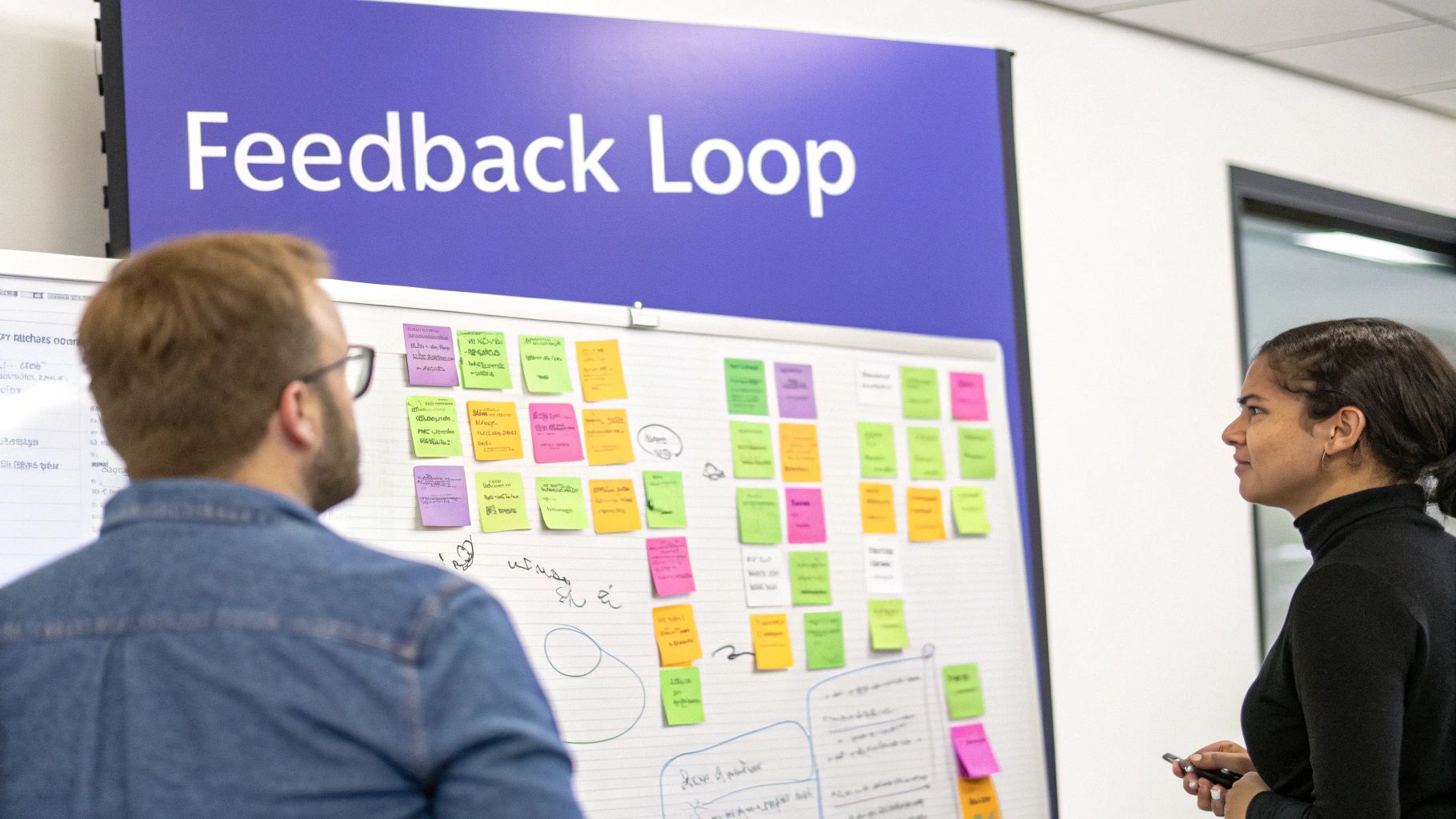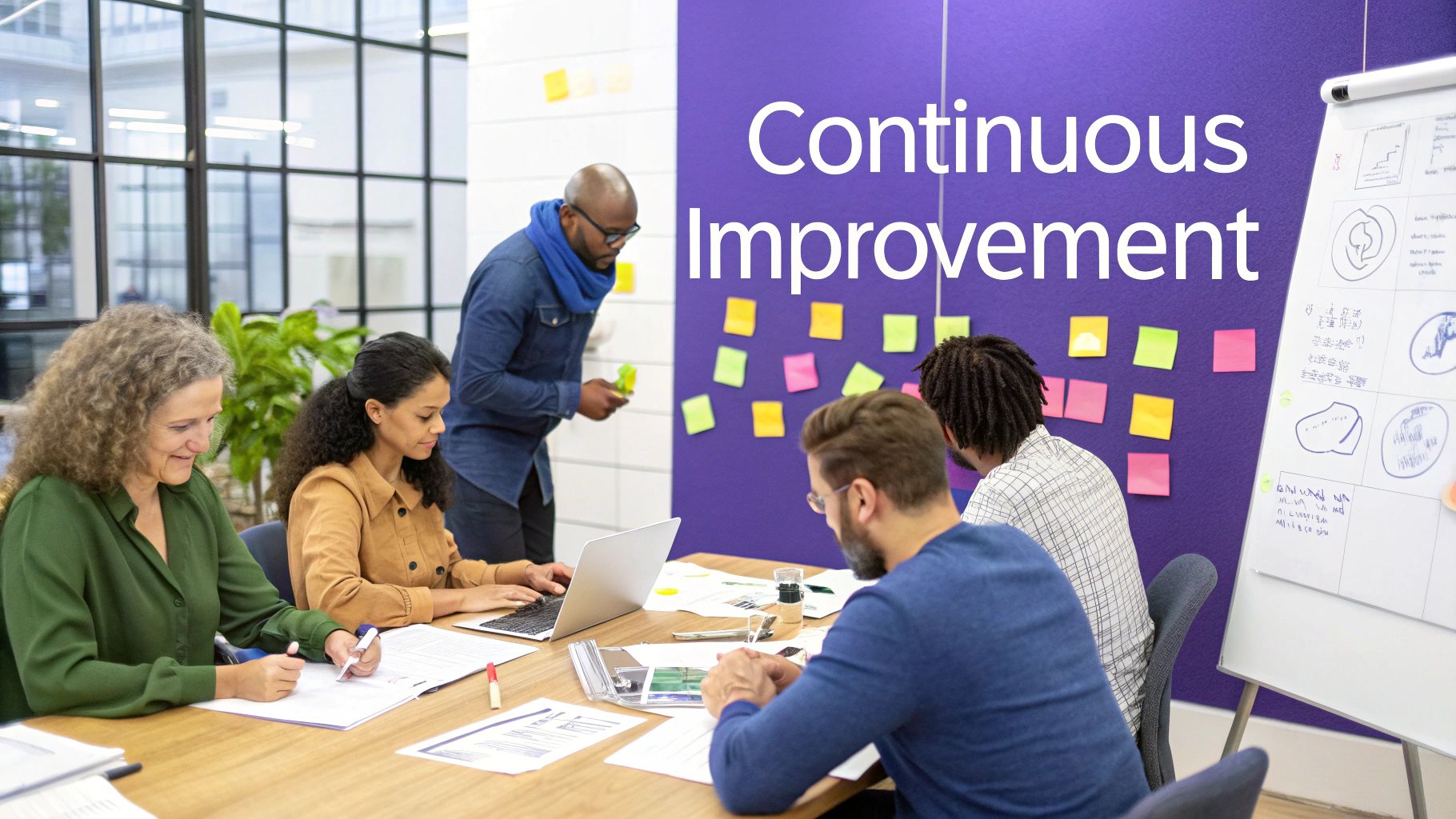Who Attends Scrum Retrospectives? A Practical Guide to Maximizing Team Success
Core Participants Who Make Retrospectives Work

The success of scrum retrospectives depends heavily on having the right people in the room. Each participant brings unique insights and perspectives that help teams reflect meaningfully on their work and drive real improvements. Let's explore the key players who make these meetings truly effective.
The Development Team: The Heart of the Retrospective
Development team members are central to every retrospective because they do the hands-on work during each sprint. Their daily experience gives them deep insight into what's working well and what needs improvement. For example, a developer might point out that a particular testing process is creating bottlenecks, sparking a valuable discussion about ways to streamline the workflow. The team's active participation and candid feedback form the foundation for identifying practical improvements.
The Scrum Master: The Facilitator of Growth
As the meeting facilitator, the Scrum Master plays a key role in making retrospectives productive. They guide discussions, ensure everyone gets heard, and keep conversations focused on solutions rather than blame. Research shows that retrospectives running 31-45 minutes tend to provide the best return on time invested. The Scrum Master maintains this optimal timeframe while creating a safe space where team members can share openly and honestly. This balanced approach leads to more meaningful insights and actionable improvements.
The Product Owner: The Bridge Between Business and Development
Though not required at every retrospective, the Product Owner offers valuable business context to technical discussions. They help connect the team's work to customer needs and business goals. For instance, they might share how users responded to a new feature, giving developers helpful perspective on their work's impact. However, the Product Owner should participate thoughtfully - their role is to add context while letting the development team drive the retrospective process.
Other Attendees: Navigating the Guest List
Sometimes stakeholders or managers join retrospectives to provide additional viewpoints. While extra input can be helpful, too many participants can make people hesitant to speak freely. Data shows that retrospectives work best with 6-10 people, representing about 57% of successful meetings. When considering extra attendees, carefully weigh whether they'll truly enhance the discussion. Learn more in our article about Transformative Scrum Retrospective Ideas for Team Growth. The goal is maintaining an environment where everyone can contribute meaningfully to improve the team's work.
Finding Your Team's Sweet Spot for Size and Impact
Now that we understand the key roles in a scrum retrospective, the next question is: what's the best team size for these meetings to be truly effective? While having the right people present matters, the number of participants plays a big role in shaping how well the meeting works. Let's explore what makes an ideal team size and how to handle different group dynamics.
The Goldilocks Principle: Not Too Big, Not Too Small
Finding the right size for your retrospective is a lot like the story of Goldilocks - it needs to be "just right." A team that's too small might not generate enough different viewpoints to spot all the important issues. But when teams get too large, people often feel less comfortable speaking up and sharing honest feedback.
Think about having just three people in a retrospective. The discussion might move quickly, but you're likely missing out on valuable insights that would come from more diverse perspectives. On the flip side, picture fifteen people trying to have a productive conversation - some folks might dominate while others barely get a word in.
Real-world data shows that teams of 6-10 people tend to have the most successful retrospectives. In fact, this size range accounts for 57% of effective meetings. This makes sense - it's enough people to bring different viewpoints while still letting everyone actively participate and feel ownership of the process.
Adapting Techniques for Different Group Sizes
Of course, you can't always have the perfect team size. The key is knowing how to adjust your approach based on your actual number of participants. For smaller groups (3-5 people), focus on activities that encourage deep discussion and shared understanding. Simple tools like brainstorming, mind mapping, and cause-effect diagrams work well here.
For larger groups with more than 10 people, try splitting into smaller discussion groups before coming back together to share insights. Methods like "1-2-4-All" or "World Cafe" help make sure everyone gets heard while keeping the overall discussion focused and productive.
Handling Growing Teams
When teams expand, keeping retrospectives effective becomes more challenging. One good approach is to regularly check if your team structure still makes sense - sometimes splitting into smaller, more focused teams is the best solution. You might also consider changing how often you meet. For instance, a larger team might benefit from shorter, more frequent retrospectives that each focus on specific topics rather than trying to cover everything in longer, less frequent sessions.
Understanding how team size affects your retrospectives and knowing how to adjust your approach accordingly helps turn these meetings from basic check-ins into valuable opportunities for team growth. This brings us to another important question: what about having managers present in retrospectives? Let's look at this often-debated topic next and explore practical ways to handle it.
Navigating the Management Presence Question

Getting the most value from scrum retrospectives starts with having the right people in the room. One key question teams often grapple with is whether managers should attend these sessions. Like many aspects of agile practices, the answer depends on several important factors that need careful consideration.
Balancing Transparency and Psychological Safety
For retrospectives to drive real improvement, team members need to feel they can speak openly about challenges and mistakes. When managers are present, some team members might hold back from sharing honest feedback out of concern for how it could affect their standing. For instance, a developer who made a mistake that caused deployment issues might hesitate to discuss it if they worry about their manager's reaction, even though analyzing that incident could help prevent similar problems in the future.
At the same time, keeping management completely in the dark isn't ideal either. Managers often provide valuable strategic context and can help remove obstacles the team identifies. The key is finding ways to maintain transparency while protecting the psychological safety that makes retrospectives effective.
When Management Attendance Can Be Beneficial
Some situations naturally lend themselves to manager participation. If a manager actively works with the team on sprint tasks, their presence makes sense since they're part of the day-to-day work being discussed. Managers who clearly demonstrate their commitment to Scrum values through actions - like encouraging experimentation and treating failures as learning opportunities - can also add value without dampening open discussion. They might help connect team-level improvements to broader organizational goals, giving more weight to the team's ideas.
Strategies for Effective Management Participation
When managers do join retrospectives, following some key practices helps maintain a productive environment. The Scrum Master should set clear expectations upfront about the manager's role as primarily an observer and listener rather than a director of the conversation. Managers can contribute most effectively by asking thoughtful questions that help the team explore issues more deeply, rather than jumping in with solutions. Using tools that allow anonymous input can also help team members share concerns more freely even with management present.
Alternative Approaches to Keeping Management Informed
Often, the best approach is finding ways to keep managers updated without having them attend every retrospective. Regular summaries of key themes and action items provide visibility while preserving the retrospective as a safe space for honest team discussion. One-on-one check-ins between the Scrum Master and manager create opportunities to discuss specific challenges or opportunities in more detail. This balanced approach helps managers stay connected to team progress while letting the retrospective serve its core purpose of enabling continuous improvement through open dialogue.
Mastering the Time and Rhythm of Retrospectives
When planning scrum retrospectives, getting the timing and format right is just as important as having the right people attend. A well-planned retrospective can help teams improve rapidly, while a poorly structured one can feel like wasted time. Let's explore how to find the right balance for your team.
The Importance of Finding the Right Rhythm
Finding the optimal length for retrospectives is crucial for team engagement. Research shows that meetings lasting between 31-45 minutes tend to be most effective, with teams reporting a satisfaction score of 8.5 out of 10. While the average retrospective runs about 71 minutes, shorter focused sessions often produce better results. This doesn't mean every meeting needs to fit this timeframe exactly, but it provides a good starting point for planning.
Adapting to Team Needs and Energy Levels
Each team has its own rhythm and needs when it comes to retrospectives. Teams working on complex projects or going through major changes may need longer sessions to process everything properly. On the other hand, teams dealing with meeting fatigue might do better with brief, frequent check-ins. The key is paying attention to how your team responds and adjusting accordingly. Regular check-ins about meeting effectiveness help ensure you're hitting the right notes.
Practical Techniques for Keeping Discussions Focused
Good time management is essential for productive retrospectives. Using timeboxes for different discussion topics helps keep conversations on track - for example, spending 15 minutes on successes and 15 minutes on areas for improvement creates helpful structure. Visual aids like whiteboards make it easier to keep everyone aligned and avoid going in circles. For remote teams, online collaboration tools are vital for keeping everyone engaged and participating actively. For more tips on running efficient meetings, check out our guide on How to create perfect daily standup meeting agenda.
Maintaining Momentum and Frequency
How often you hold retrospectives directly impacts their effectiveness. Most teams do them after each two-week sprint, but larger teams (over 10% of cases) may benefit from more frequent, shorter sessions to maintain good feedback loops. The trick is finding the right balance - too many meetings can overwhelm the team, while too few can slow down improvement. Data shows that successful teams typically include 6-10 people in retrospectives, suggesting this size allows for meaningful discussion while staying focused. By experimenting with different frequencies and monitoring the impact, teams can find their ideal cadence for continuous improvement.
Creating Space for Authentic Participation

A successful scrum retrospective needs more than just the right people in the room - it requires an environment where everyone feels safe to speak up and contribute meaningfully. When team members can share openly and honestly, retrospectives lead to real improvements. Let's explore practical ways to build this kind of environment.
Building Psychological Safety: The Foundation of Open Communication
For team members to speak candidly, they need to know they won't face judgment or negative consequences. Think about a developer who hits a major roadblock during a sprint. In a supportive environment, they'll feel comfortable bringing this up, helping the team spot and fix process issues early. Without that safety, problems often stay hidden until they become much bigger headaches. This is why Scrum Masters play such a key role in setting clear ground rules and making sure discussions stay respectful and constructive.
Encouraging Honest Feedback: Techniques for Every Voice
Getting real feedback requires more than just asking for it. Some people naturally speak up while others hang back, so you need specific techniques to draw out all voices. For example, anonymous feedback tools can help quieter team members share thoughts they might not voice publicly. The "Round Robin" approach, where everyone takes turns contributing, ensures no one gets overlooked. You might also need ice breakers or team activities to build trust, especially with remote teams or those spanning different cultures.
Breaking Through Surface-Level Discussions
Teams often get stuck discussing symptoms rather than root causes. The "5 Whys" technique helps dig deeper by repeatedly asking "why" until you uncover the real issue. It also helps to focus on specific examples rather than vague problems. Instead of a general discussion about "communication issues," examine a particular miscommunication that occurred and what led to it. This concrete approach makes it easier to find practical solutions.
Strategies for Virtual and Cross-Cultural Teams
Remote teams and those spanning different cultures face extra challenges in creating open dialogue. Time zones, language differences, and varying communication styles can all create barriers. Combat this by using shared online whiteboards or surveys that let people contribute when it works for them. Visual aids and collaborative tools can help bridge language gaps. Some teams benefit from having key information in multiple languages or using real-time translation tools. The key is adapting your approach to fit your specific team's needs while keeping the focus on building trust and encouraging open dialogue. When done right, these adaptations help teams turn their retrospectives into powerful tools for continuous improvement.
Measuring What Matters in Retrospectives

Good retrospectives need more than just open discussion - they require a clear way to track progress and measure impact. But how can teams know if their retrospectives are making a real difference? The key is focusing on meaningful metrics while also gathering qualitative feedback from team members.
Quantifying Progress: Metrics That Matter
Start by tracking concrete numbers that show results. Count how many action items come from each retrospective and what percentage get completed by the next sprint. This shows if insights are turning into real changes. You can also measure sprint velocity before and after making improvements identified in retrospectives - increasing velocity suggests the changes are helping the team work better. Just remember that numbers only tell part of the story, which is why qualitative feedback matters too.
Qualitative Insights: The Human Element
Getting input directly from team members provides deeper understanding. Ask specific questions like "What value did you get from this retrospective?" or "Did you feel comfortable sharing your thoughts?" Anonymous surveys work well for honest responses without pressure. This feedback reveals both the impact of implemented changes and how well the retrospective process itself is working for the team.
Demonstrating Value: Showing the Impact
To maintain support for retrospectives, show stakeholders the concrete results. Create reports that connect retrospective action items to improved metrics - for example, if addressing communication issues led to 20% fewer misunderstandings between teams. Learn more in our article about What Is a Scrum Retrospective & A Guide to Continuous Improvement. Including positive feedback from team members adds personal perspectives that strengthen the data.
Refining the Process: Continuous Improvement in Action
Like any team practice, retrospectives can always get better. Regularly assess what's working and what needs adjustment. Try different formats and facilitation approaches based on team needs - if people feel rushed, consider longer meetings or a narrower focus. Review whether action items fix root causes or just symptoms. This ongoing refinement keeps retrospectives useful for improving team performance and achieving goals.